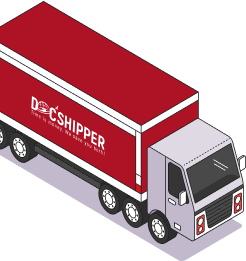Sea Freight from China
Built for Better Margins
Whether you're shipping to Europe, the U.S., or beyond, DocShipper provides end-to-end sea freight services
with FCL and LCL options customized to fit your needs.




Our Container Shipping Solutions
Container shipping is the foundation of global trade, using standard 20ft and 40ft containers (including High Cube). Depending on your volumes, choose between FCL (Full Container Load) or LCL (Less-than-Container Load).
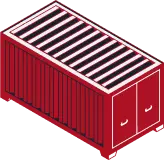
Full Container Load (FCL)
FCL is ideal for businesses with enough goods to fill an entire shipping container from China. It offers the following benefits:
- Exclusive use of a container reserved solely for your goods.
- Perfect for large quantities and high-volume shipments.
- Cost-effective solution with lower costs per unit shipped.
- Reduced risk with no handling by other shippers.
- Faster and direct delivery, as the container avoids stops for other shipments.
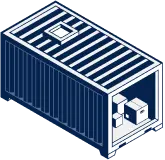
Less than Container Load (LCL)
LCL provides a flexible option for businesses that don’t have enough goods to fill a full container. Key benefits include:
- Share container space with other shippers.
- Perfect for smaller volume shipments.
- Cost-effective through shared container usage.
- Flexible space allocation tailored to your needs.
- Pricing calculated per cubic meter or weight, ideal for shipments under 15m³
Our Special Shipping Solutions
Ro-Ro (Roll-on/Roll-off)
Ideal for transporting vehicles like cars, trucks, or construction machinery.
Oversized Cargo
This service is adapted for large or oversized goods that cannot be transported in standard containers.
Dry Bulk
Used for transporting unpackaged raw materials such as grains, minerals, or construction materials.
Refrigerated Goods (Reefer)
Designed for products requiring temperature control, such as perishable foods, pharmaceuticals, or other sensitive goods.
Shipping Made Easy, From China to Anywhere
Worldwide Shipping
Wherever you need to send your goods, we cover worldwide destinations as your sea freight forwarder. Whether Europe, the Americas, or Asia, your shipments are in good hands, regardless of distance.


Every Type of Cargo
From oversized goods to refrigerated products, we handle all types of freight. Whatever your shipment, we find the best solution for your sea transport from China needs.


End-to-End Management
Need a complete service? We’ve got you covered from start to finish. From collecting your goods to customs clearance and ensuring safe delivery to the final destination, we manage every detail of the shipping process.


Paperwork Made Simple
Administrative formalities shouldn’t slow down your operations. We simplify the management of necessary documents, ensuring everything is in order for hassle-free shipping.


Comprehensive Support Beyond Sea Freight
At DocShipper U.K., our role doesn’t stop at the port.
DocShipper’s approach is based on coordination rather than simply moving cargo. We centralise communication with freight forwarders, customs brokers, and local partners so that businesses don’t have to deal with multiple providers on their own. This coordination extends to compliance as well: we make sure all documentation, licenses, and customs requirements are handled properly in both the U.K. and the destination country.
We provide complete logistics support designed to integrate sea freight smoothly into your supply chain. Every business faces unique challenges, which is why our solutions go far beyond moving containers from port to port.


Customs Clearance
Our customs clearance specialists ensure that declarations, duties, and compliance checks are handled in line with HMRC requirements, preventing costly delays.

Last-Mile Delivery
For the final stretch, our trusted delivery partners take over, transporting your goods directly to warehouses, retail outlets, or even private addresses, ensuring reliability from the terminal to the end customer.

Storage
If your cargo requires storage, we offer flexible warehousing facilities close to major U.K. and international ports, whether for short-term consolidation or long-term stock holding.

Multimodal Service
For projects requiring broader coverage, we offer multimodal options that combine sea with air or road freight. This allows you to balance speed and cost, all managed by your dedicated DocShipper contact.
Your Sea Freight Shipments from/to the U.K., Managed from A to Z
From supplier to customer, DocShipper takes care of everything, with competitive rates and total transparency.


Steps of your Sea Freight From China
Each shipment from China demands careful management at every stage. From the initial contact to final delivery, we handle all aspects to ensure a smooth and secure process.

Initial
contact
We start by discussing your specific needs in detail, defining shipment requirements, and providing a customized and accurate quote.

Document
Verification
Our team reviews all essential documents to ensure compliance with customs regulations and avoid delays.

Goods Collection
We coordinate the transport of your goods from the warehouse or supplier in China to the export port, preparing everything for shipping by sea.

Export Customs Clearance
Our customs brokers handle all formalities to ensure your goods legally exit China, following all regulatory requirements.

Handling and Processing at Origin
At the port, goods are carefully received, thoroughly processed, and securely loaded onto the cargo ship for transport.

Sea Transport
Your products are carefully transported by sea to the destination port, ensuring they arrive safely and efficiently, ready for the next stage of their journey.

Handling and Processing at Destination
Once at the destination port, goods are unloaded, processed, and prepped for the final delivery stage.

Import Customs Clearance
We manage all import customs formalities, allowing your goods to enter the destination country seamlessly.

Final Delivery
The goods are transported to their final destination with care, whether that’s your warehouse, a distribution center, or another location of your choice.
More reasons to choose us
Real-Time Tracking
Through a dedicated platform, you can track every step of your shipment in real time, ensuring full visibility from departure in China to arrival in Europe or elsewhere.
24/7 Support
A single point of contact, available 24/7, to answer your questions and ensure smooth communication, regardless of time zone.
Highly Competitive Pricing
Our global network of partners allows us to offer the best ocean freight shipping proces, especially for China-Europe routes, thanks to our local presence and relationships with carriers.
Personalized Support
Clients appreciate our flexible and personalized approach, quickly helping to overcome obstacles for the best customer experience possible.
6100 +
Clients9200 +
Operations230 +
K CBM Chartered4.8 +
ReviewsClients Testimonials
We can't make this up - See why businesses worldwide trust us with their shipments every day.
I contacted DocShipper to organize the import of board games from Asia to Switzerland. Despite my lack of experience in the field and the modest size of my request, my dealings with the staff were always professional and efficient. I received sound advice and the staff always took the time to answer my questions. I look forward to working with DocShipper for the import of my goods and highly recommend their services.
Mavrik Grangier
December 10, 2024My name is Ad Van Den Bosh. I am a Dutch business man cross-trading in the Far East. I reached Robert Houwayek (DocShipper's representative) to clear a 40HC of greenhouse equipment from Qingdao, and deliver it to Lan Krabue in no time. He suggested that I request a Form E, which I did from the supplier, and was able to enjoy a preferential tariff treatment. DocShipper, a way to help you save both time and money!!
Ad van den Bosch
March 5, 2024I recently used Docshipper to ship my appliances from Germany to Thailand, and I'm thrilled with the service I received! [...]The team was professional, responsive, and kept me informed every step of the way. The packaging and handling of my appliances were top-notch, and they arrived in perfect condition. I was impressed with the attention to detail and care taken to ensure a safe and successful transport. I really recommend Docshipper for it.
Chemmie Chatuphorn
November 28, 2024In the event of goods being stuck at customs, Robert [...] is a customs broker you should arguably consider to release your cargo. Once I knew that my scale modeling tools coming from Spain are being withheld at Suvarnabhumi Airport, I resorted to him to release it and handle the last mile delivery. All what he asked me is to send 2 emails to be able to do it! [...] Well guess what, within 48 hours, it was done! I got my parcel at my place in Phuket.
Chan chan
Mar 5, 2024A vice president caught up in the thick of thin things, an EXW shipment of plumbing supplies for irrigation from Eureka California to Costa Rica is definitely not what I’d like to have on my agenda. Robert’s hang-in-there posture toward any arising challenges in shipping. [...] skillfully handled all US export formalities incl. SED/AES filing, not to mention the sea freight from Oakland POL. Everything ended up working out like a charm!
Dave Sheppard
July 10, 2024I feel they covered everything. DocShipper shipped a 20- ft Milvan overseas to Laem Chabang for a customer. The team was responsible for shipping the shipping to another country. Having very little knowledge in this area, I didn't know how to organise myself . One week after my arrival on the Asian continent. Marc O. Was available at all times and nearly instant feedback. Made a stressful event much easier and he definitely knows his job.
Anonymous, Indiana
Aug 9, 2023No more stress when shipping from China.
From pick-up to the arrival of your goods, everything is fully managed. You focus on your business, and we take care of the rest with competitive rates and personalized support.
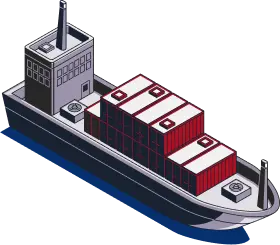
When to choose (or not) Sea freight from China
Although widely popular, ocean shipping isn’t always the best transport option.
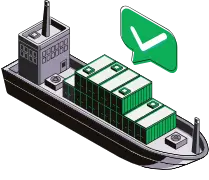
When should you choose it?
- When shipping large volumes at a lower cost
- For transporting heavy or oversized goods
- When delivery time is not a priority
- For long-distance international shipments
- When dealing with non-perishable products
- If the destination has well-connected ports
- When minimal handling is required for the goods
- For items that can endure varying climate conditions

When should you avoid it?
- When shipments are urgent and time-sensitive
- For short or local transportation distances
- When handling high-value or delicate goods
- If enhanced security measures are required
- When access to port infrastructure is limited
- For frequent, small-volume shipments
- When managing complex or short supply chains
- During periods of seasonal demand fluctuations
Required documents
for sea freight
To ensure your goods travel in full compliance, several documents are essential.
- Bill of Lading
- Packing List
- Certificate of Origin
- Bill of Lading (B/L)
- Commercial Invoice
- Insurance Certificate
- Import/Export License
Have questions? We
have answers
Ask Questions.
Get clear answer.
Not sure if it’s the right solution or have doubts in mind? No problem—just ask us. We’ll guide you honestly, no commitment required.




